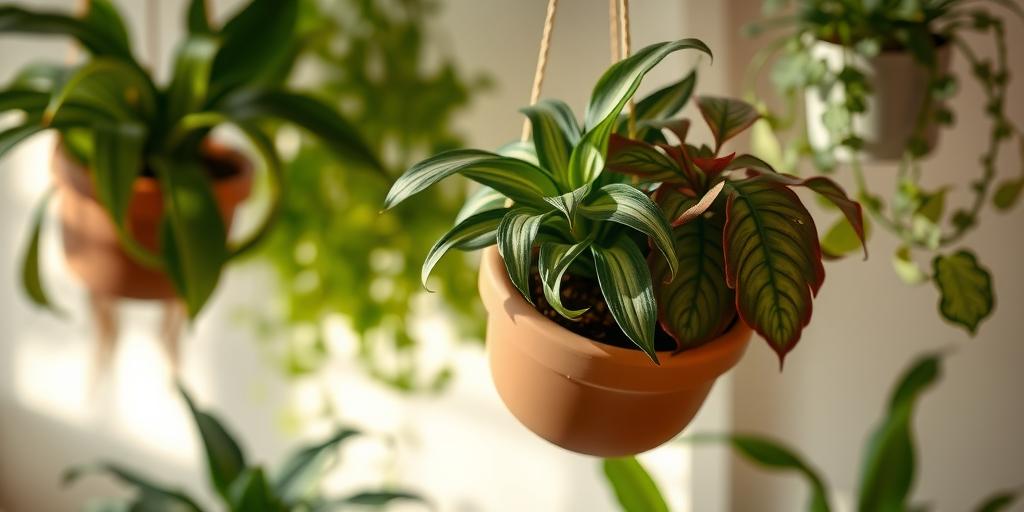
Best Low Light Hanging Plants That Resist Root Rot and Thrive (2025)
Discover the best low-light hanging plants that resist root rot and thrive in dim spaces! Perfect for beginners and plant lovers—easy care, lush growth, and stunning greenery.
Introduction
Do you love houseplants but struggle with low-light spaces and root rot? You’re not alone! Many indoor gardeners face these challenges, but the good news is—some plants are practically made for these conditions. Whether you have a shady corner, a dim bathroom, or just want a low-maintenance hanging plant, we’ve got you covered. Did you know that overwatering is the #1 cause of root rot in houseplants? But fear not! We’ve curated a list of resilient, low-light hanging plants that not only survive but thrive with minimal care. Let’s dive in!
Why Choose Low Light Hanging Plants That Resist Root Rot?
Benefits of Low-Light Plants for Indoor Spaces
Not every home is flooded with natural sunlight, and that’s okay! Low-light hanging plants are perfect for spaces with minimal windows or shaded corners. They bring life to dim areas without demanding constant attention. Plus, they help purify the air, reduce stress, and add a touch of nature to urban living. If you’ve struggled with plants that wilt in dim lighting, low-light varieties are your best bet.
How Root Rot Develops and Why Some Plants Resist It
Root rot is a silent killer—it happens when plants sit in soggy soil, suffocating their roots. Overwatering is usually the culprit, but poor drainage and compact soil make it worse. Some plants, however, have evolved to handle occasional neglect or excess moisture. They store water in their leaves (like ZZ plants) or have resilient root systems (like pothos), making them less prone to rot. Choosing these varieties means fewer worries if you forget a watering or two.
Why Hanging Plants Are Ideal for Small Spaces and Air Purification
Hanging plants are space-savers—they don’t take up precious floor or shelf real estate. They also improve air circulation around their leaves, which helps prevent mold and mildew. Many low-light hanging plants, like spider plants and philodendrons, are natural air purifiers, filtering out toxins. Whether you live in a tiny apartment or just want to maximize greenery, hanging plants are a stylish and practical solution.
Top Low Light Hanging Plants That Resist Root Rot
Pothos (Epipremnum aureum) – Nearly Indestructible
Pothos is the ultimate beginner-friendly plant. It thrives in low light, bounces back from underwatering, and can even grow in water alone. Its trailing vines make it perfect for hanging baskets, and it rarely suffers from root rot thanks to its hardy nature. Golden pothos, marble queen, or neon varieties all add a pop of color with minimal effort.
Spider Plant (Chlorophytum comosum) – Adaptable and Air-Purifying
Spider plants are tough—they tolerate irregular watering and still produce cascading baby “spiderettes.” They’re excellent for hanging planters because their arching leaves spill beautifully over edges. Plus, they’re known for removing formaldehyde from the air. Just let the soil dry out between waterings, and they’ll stay happy.
ZZ Plant (Zamioculcas zamiifolia) – Thrives in Neglect
The ZZ plant is practically bulletproof. It stores water in its rhizomes, so it can go weeks without a drink. It grows well in dark corners and resists root rot like a champ. While it’s not a traditional “hanging” plant, placing it in a elevated planter lets its glossy leaves drape elegantly.
Peperomia – Compact and Water-Efficient
Peperomias come in many textures—from ripple to watermelon varieties—and their small size makes them ideal for hanging displays. They prefer drying out between waterings, reducing rot risk. Their thick leaves retain moisture, so they’re forgiving if you skip a watering session.
Philodendron Heartleaf – Fast-Growing and Forgiving
Heartleaf philodendrons are lush, vining plants that thrive in low to moderate light. They’re forgiving of overwatering (within reason) and adapt well to humidity, making them great for bathrooms. Their heart-shaped leaves add a romantic touch to any hanging planter.
How to Care for Low Light Hanging Plants
Watering Tips to Prevent Root Rot (Less Is More!)
The golden rule? Wait until the top inch of soil is dry before watering. Stick your finger in—if it feels damp, hold off. Overwatering is the fastest way to kill a low-light plant. Many of these varieties prefer slightly dry conditions, so err on the side of underwatering.
Best Soil Mixes for Drainage and Aeration
A well-draining mix is key. Combine potting soil with perlite, orchid bark, or coarse sand to improve airflow. Avoid dense, moisture-retentive soils. For extra protection, use pots with drainage holes or add a layer of pebbles at the bottom.
Ideal Humidity and Temperature Conditions
Most low-light hanging plants enjoy moderate humidity (40–60%). Bathrooms or kitchens are great spots. If your air is dry, mist occasionally or group plants together. Keep them away from cold drafts or heating vents—consistent temps between 65–80°F are ideal.
When and How to Fertilize for Optimal Growth
During spring and summer, feed plants monthly with a diluted, balanced fertilizer. Skip fertilizing in winter when growth slows. Over-fertilizing can harm roots, so follow the “less is more” approach here too.
Common Mistakes to Avoid with Low Light Hanging Plants
Overwatering vs. Underwatering Signs
Yellow, mushy leaves? Likely overwatering. Crispy, drooping leaves? Probably underwatering. Adjust your routine based on the plant’s cues. When in doubt, wait a few extra days before watering.
Choosing the Wrong Pot or Hanging Planter
Avoid pots without drainage—they trap water. Lightweight plastic or fiberglass planters are best for hanging (heavy ceramic can strain hooks). Ensure your hanger can support the weight when the soil is wet.
Ignoring Pest Prevention
Spider mites and fungus gnats love damp soil. Let soil dry out between waterings to deter gnats. Wipe leaves occasionally to prevent mites. Neem oil or insecticidal soap can help if pests appear.
Placing Plants in Too Dark or Drafty Spots
Even low-light plants need some indirect light. If a corner is pitch-black, consider a grow light. Also, avoid spots near AC units or open windows where cold drafts can shock plants.
Styling Tips for Hanging Plants in Low Light Spaces
Best Spots to Hang Plants
Bathrooms with frosted windows, hallways with ambient light, or office nooks are perfect. North-facing windows also provide gentle, indirect light.
Creative Hanging Ideas
Try macramé hangers for a boho vibe, wall-mounted planters for a modern look, or tiered displays to maximize vertical space. Mix different trailing plants for texture.
Pairing Plants for a Lush, Layered Look
Combine pothos (long vines) with peperomia (compact foliage) for contrast. Add a spider plant for height variation. Grouping plants at different levels creates depth and visual interest.
Conclusion
Low light doesn’t mean no greenery! With the right plants—like Pothos, Spider Plants, and ZZ Plants—you can enjoy lush, thriving foliage without the fear of root rot. Remember: proper watering, well-draining soil, and the right placement are key. Ready to transform your space? Pick one of these hardy plants and watch them flourish! Got a favorite low-light hanging plant? Share it in the comments below!
